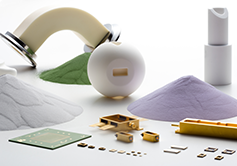Fine Ceramics, sometimes referred to as "advanced ceramics," are engineered materials that support the development of cutting-edge technology.
- HOME
- Characteristics of Fine Ceramics
- Chemistry and Medical Care - Biocompatibility
Chemistry and Medical Care (2)
Biocompatibility with Internal Chemistry of the Human Body
Fine Ceramics possess a high degree of chemical and physical stability and are biocompatible with the internal chemistry of the human body.
The artificial joints shown below are made of materials that are compatible with the internal chemistry of the human body.

Applications: Biocompatible components for orthopedic joint replacement systems.
Description
Biocompatibility
Fine Ceramics are light, strong and chemically stable. Due to these characteristics, Fine Ceramics have helped advance the field of medical science, and Fine Ceramic materials and process technologies have become crucial to the development of contemporary medicine.
The term "Fine Ceramics" is interchangeable with "advanced ceramics," "technical ceramics" and "engineered ceramics." Use varies by region and industry.
People who read this page also read.

Chemistry and Medical Care (1)
Chemistry and Medical Care (1)
Highly Resistant to Chemicals
Highly Resistant to Chemicals
Characteristics of Fine Ceramics

Different Types of Fine Ceramics
Different Types of Fine Ceramics
Wide Variety of Products to Support both Industry and Society
Wide Variety of Products to Support both Industry and Society
Introduction to Fine Ceramics

Fine Ceramics Inside the Body
Fine Ceramics Inside the Body
Restores Proper Function to Joints and Skull
Restores Proper Function to Joints and Skull
Learning about Fine Ceramics
If you want to use ceramics in business, click here.
Kyocera's Fine Ceramics products (All websites below open in a separate window.)
Product Category
 Semiconductor / LCD Processing Equipment
Semiconductor / LCD Processing Equipment
 Life / Culture / Industrial Machines
Life / Culture / Industrial Machines
 Wireless Communications
Wireless Communications
 Computer Peripherals
Computer Peripherals
 Environmental Preservation / Renewable Energy
Environmental Preservation / Renewable Energy
 Medical Equipment / Devices
Medical Equipment / Devices
 Single-Crystal Sapphire Products
Single-Crystal Sapphire Products
 Metallized / Vacuum Components
Metallized / Vacuum Components
 Electronics Industry
Electronics Industry
 Heaters
Heaters
 Piezoelectric Ceramics
Piezoelectric Ceramics
Search by Material
 Alumina
Alumina
 Silicon Nitride
Silicon Nitride
 Silicon Carbide
Silicon Carbide
 Sapphire
Sapphire
 Zirconia
Zirconia
 Cordierite
Cordierite
 Yttria
Yttria
 Aluminum Nitride
Aluminum Nitride
 Cermet
Cermet
 Mullite
Mullite
 Steatite
Steatite
 Forsterite
Forsterite
Search by Property/Characteristic


- Thermal Properties
- Coefficient of Thermal Expansion
- Thermal Conductivity
- Heat Shock Resistance

- Electrical Properties
- Insulation / Semiconductivity

- Chemical Properties
- Chemical Resistance










